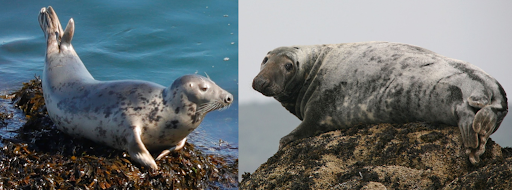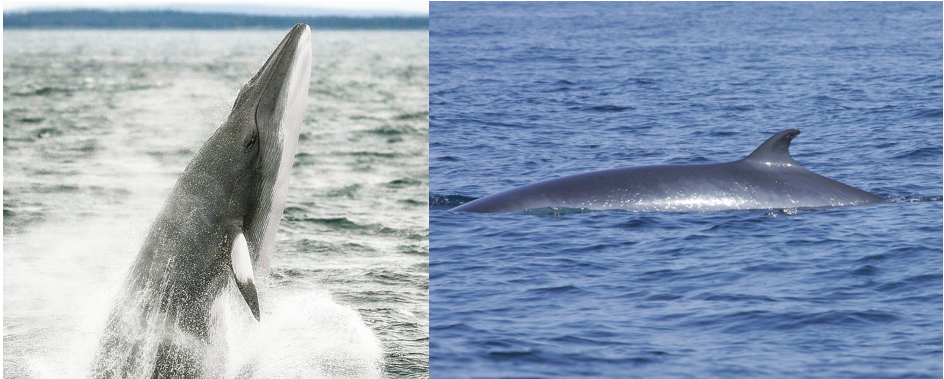Marine mammals, including seals and dolphins, are generally well-loved and charismatic species. Some people may be surprised by the variety of marine mammals we are lucky enough to have living around and visiting our coasts.
In this guide we will summarise a number of the marine mammal species you are most likely to spot in UK waters, and how to identify them. Identifying marine mammals can be a rather challenging task as often only a bobbing head or fin is visible, but knowing what features to look out for can sometimes be enough to make a fairly confident identification.
It is very important to note that seals and cetaceans are legally protected in the UK and all efforts should be made not to cause disturbance. It is strongly recommended that you do not approach marine mammals in person or by boat – any interactions should be fully on their terms.
Seals (Pinnipeds)
Two species of seal make our coasts their home: the common and grey seals. Both species are members of the family Phocidae, the true seals. Unlike other pinnipeds, such as sea lions, the true seals lack external ear flaps hence their other name, the earless seals.
Common Seal – Phoca vitulina

Also known as harbour seals due to their common presence in these locations.
Appearance: Rather cat-like in appearance, with a relatively shorter snout than the grey seal and a more concave forehead. Their nostrils are closer together than the grey, creating a ‘V-shape’. Often the pelage (coat) is grey and speckled. Both males and females of this species look similar.
Behaviour: When on land, the common seal can be seen to lay on its side and hold its tail and head in the air forming a banana-like shape. They tend to be found in smaller aggregations on land than grey seals, leaving more space between individuals.
Where are they seen? Despite their name, common seals are seen less frequently than grey seals, with their population numbers less than half that of the grey. Abundant in northern England and Scotland, but rarely seen in the south. Generally seen coastally, or hauled out on rocks and beaches.
Grey Seal – Halichoerus grypus

The grey seal is the most common seal species in the UK, and the UK population makes up roughly 40% of the global population.
Appearance: Grey seals have a ‘blotchy’ pelage and tend to be darker than common seals. They are also larger in size, have a more prominent snout and their nostrils are separate and roughly parallel. Female grey seals can be more difficult to separate from the common seal as they do not have such a striking snout.
Behaviour: Rather gregarious seals, they often haul out in large colonies during the breeding and moulting season. Grey seals are generally curious and on occasion will approach a boat or humans in the water to investigate (see note about disturbance, any interactions should be on the animal’s terms).
Where are they seen? Common around the UK, particularly along the western coast, Scotland and Norfolk. Generally seen coastally, or hauled out on rocks and beaches.
Dolphins and Whales (Cetaceans)
At least 25 species of cetacean have been spotted in UK waters, although significantly fewer are regularly seen. Some species are resident year-round while others simply pass through seasonally. All cetaceans, including porpoises and dolphins, are technically whales, although commonly only the larger species are referred to by this name. They are split into two groups: the toothed whales that actively hunt prey and the larger baleen whales, that use sheets of keratin (baleen) to filter feed.
Toothed whales (Odontocetes)
Harbour porpoise – Phocoena phocoena

Also known as the common porpoise. The name porpoise is derived from ‘porcus’, the Latin word for ‘pig’. Colloquially they are sometimes referred to as the ‘puffing pig’ due to the characteristic ‘chuff’ made when surfacing.
Appearance: The smallest cetacean in the UK, not exceeding a length of 1.5 metres. Their dorsal fin is small and triangular and their head is rounded at the front, lacking a clear beak.
Behaviour: Generally seen as individuals or in small groups with 2-5 members. They often surface three or four times before disappearing for a longer dive. Elusive and unlikely to approach boats.
Where are they seen? Seen nationwide in shallow, coastal waters.
Common dolphin – Delphinus delphis

Appearance: A sleek and agile dolphin with an elongated beak and sickle-shaped dorsal fin. Easily identified by their cream and white ‘hourglass’ colouration.
Behaviour: Acrobatic and generally inquisitive dolphins. Common dolphins are frequently seen bow-riding alongside boats and leaping from the water. On occasion, groups join together to form a super-pod of hundreds of individuals. If a group of cetaceans this large is spotted in UK waters, it is almost certainly common dolphins!
Where are they seen? They tend to spend most of their time offshore in deeper waters, so are more likely to be seen by boat rather than from the shore.
Bottlenose dolphin – Tursiops truncatus

Appearance: A large, muscular dolphin with fairly uniform grey colouration. British bottlenose dolphins are the largest in the world, presumably to allow them to cope with our colder waters.
Behaviour: Travel and feed in small-medium pods, although lone animals have been seen around the UK.
Where are they seen? Bottlenose dolphins can be spotted all around our coasts if you are lucky, but are most likely to be seen in the Moray Firth, Cardigan Bay and Cornwall, where resident pods reside.
Risso’s dolphin – Grampus griseus

Appearance: Unmistakable dolphins with distinct colouration except as calves. Risso’s begin their lives dark grey but become paler and scarred with age. These marks occur from social interactions with other Risso’s and during predation events, such as with squid.
Behaviour: Studies show Risso’s dolphins to be social animals that remain in long-established pods. They are fairly active at the surface of the water and can be seen ‘spy-hopping’ – holding themselves vertically in the water with only their heads bobbing above the surface.
Where are they seen? In deeper, offshore waters. Generally spotted along the west coast of Scotland and around the Isle of Man.
Orca – Orcinus orca

Appearance: Striking and characteristic large black cetaceans with white eye and saddle (behind dorsal fin) patches. Male orcas have the largest dorsal fin of any species at up to 6ft, significantly taller than the female orcas.
Behaviour: Orcas are very social animals that remain with their maternal pod. Different groups display different feeding strategies, tending to focus on either smaller marine mammals or fish. Orcas are fairly active at the surface and can be seen spy-hopping or tail-slapping the water.
Where are they seen? The UK’s only resident pod (8 individuals) tends to be seen on the West coast of Scotland but were spotted roaming as far south as Cornwall in early 2021. Further transient groups appear in the summer but are generally limited to northern Scotland, Orkney and Shetland.
Baleen whales (Mysticetes)
Minke Whale – Balaenoptera acutorostrata

Appearance: The smallest baleen whale seen in the UK at around 9 metres in length when fully grown. A dark grey whale with a white underside with a sickle-shaped dorsal fin located roughly two-thirds along the back. If you’re lucky enough to spot the pectoral (side) fins, the white ‘armbands’ will confidently identify this species.
Behaviour: Generally seen alone or in small groups. Minke can be seen to lunge feed at the surface, side-lunging with open mouths to take in large quantities of water and therefore prey. From afar, aggregations of seabirds can be the first hint of such a feeding event.
Where are they seen? Minke are the most commonly spotted baleen whale and can be seen nationwide. Sightings are significantly higher around Scotland and the south-west.
Fin Whale – Balaenoptera physalus

Appearance: The second largest whale in the world, reaching up to 24 metres in the northern hemisphere. Very dark colouration on the upper body, with the dorsal fin placed far back on the back. The fin whale has an asymmetrically coloured lower jaw, with bright white only present on the right-hand side (as shown in the above image).
Behaviour: Seen on their own, or in small groups of up to 7 individuals. When diving their tail does not rise above the surface, unlike some other large whales.
Where are they seen? Rare in UK waters, but most likely to be seen around northern Scotland and the Hebrides, although sightings have occurred off Cornwall and Ireland in recent years.






